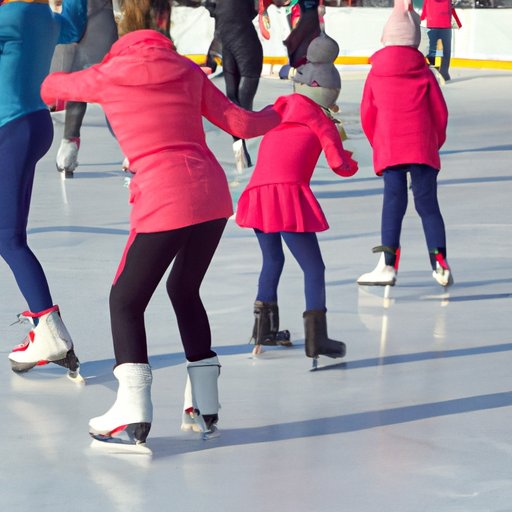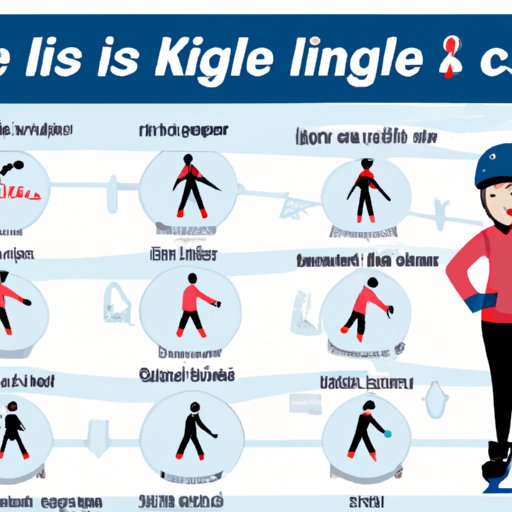Learn How to Ice Skate: A Beginner’s Guide
Ice skating is not only a beloved winter pastime but also a beautiful art form and an impressive sport. Whether you are a complete beginner or already have some experience, ice skating is a fun and challenging activity that can improve your balance, coordination, and overall fitness. In this guide, we’ll explore the basics of ice skating, from how to get started to advanced techniques, and provide you with useful tips, advice, and stories from professional skaters.
Step-by-Step Beginner’s Guide to Ice Skating
Before stepping on the ice, it’s essential to know some basic steps and movements that you’ll need to master. The first step in ice skating is to push off. To do so, stand in a comfortable and relaxed position with your knees slightly bent and arms extended in front of you. Then, take a step forward with one foot while pushing off with the other foot to slide forward on the ice. Repeat this movement with your other foot, and gradually build momentum as you keep pushing off.
Once you can push off with both feet, you can learn how to glide, which entails transferring your weight from one foot to the other while moving forward. To glide, keep your knees slightly bent and your weight centered over your feet. Take one step forward, then lift your trailing foot and bring it behind your front foot, shifting your weight onto it. Alternate between gliding on your right and left foot to get a feel for the movement, and try to keep your body stable and relaxed.
Stopping is another essential skill in ice skating, and there are several ways to do it. The most common method for beginners is the snowplow stop, which involves turning your feet and toes inward while pushing the heels out to form a V shape with the blades. This position creates friction against the ice and slows you down gradually. As you get better, you can try more advanced stopping techniques, such as the hockey stop or the T-stop. Remember to practice stopping on both sides and to stay balanced while doing so.
To maintain balance on the ice, it’s crucial to keep your core engaged and your posture aligned. Try to keep your head up and your eyes forward, and keep your arms and hands relaxed but not flailing around. Avoid looking at your feet, and instead focus on a fixed point on the ice ahead of you. Additionally, try to keep your knees bent and your weight centered over your feet, not leaning too much forward or backward. Use your arms for balance and momentum, swinging them back and forth as you move.
As you gain more confidence and skill, you can progress to more advanced techniques, such as crossovers, jumps, spins, and footwork. These moves require more speed, agility, and precision, and can be challenging to master. However, with practice, patience, and proper coaching, you can enhance your skating abilities and enjoy the thrill of performing complex routines on the ice.
5 Common Mistakes to Avoid When Learning to Ice Skate
Learning to ice skate can be daunting, and many beginners make common mistakes that can hinder their progress and safety. Here are some of the most frequent errors to watch out for and how to avoid them:
1. Leaning too far forward or backward: Keeping your balance on the ice requires staying centered over your feet and avoiding excessive leaning. To prevent this, try to keep your head up and your weight distributed evenly, and aim for small, controlled movements.
2. Stiffening up: Ice skating requires flexibility, fluidity, and control. Avoid tensing up or holding your breath, and try to relax your muscles and breathe normally. This will help you move more smoothly and gracefully on the ice.
3. Not using your edges: Skates have two edges, inside and outside, that you can use to turn, stop or change direction. Many beginners don’t utilize their edges, which can result in unstable or inefficient skating. Practice shifting your weight and using your edges to control your movements and gain more confidence on the ice.
4. Looking at the ground: It’s tempting to look down at your feet when skating, but this can throw off your balance and reduce your awareness of other skaters and obstacles. Instead, look straight ahead or slightly up and trust your body instinctively to adjust to the ice conditions.
5. Pushing off too hard: While it’s essential to generate momentum by pushing off, overdoing it can lead to slipping, tripping, or falling. Try to push off gently and progressively increase your speed and distance over time. Also, avoid lifting or rushing your feet, and keep your knees slightly bent to absorb the impact of the ice.
How to Choose the Right Ice Skates for Your Skill Level
Selecting the best ice skates for your level and needs can make a significant difference in your comfort, performance, and safety on the ice. There are two main types of skates: figure skates and hockey skates, each with distinct features and designs. Figure skates are more curved and have longer blades, making them suitable for jumps, spins, and artistic moves. Hockey skates, on the other hand, are flatter and have shorter blades, making them more maneuverable and stable for fast movements and stops.
When buying ice skates, consider your skill level, foot size and shape, and budget. Look for skates that fit snugly but not too tightly, with good ankle support and padding. Try them on with thin socks and walk around to ensure they are comfortable and well-fitted. Also, check the blade quality and sharpness, as well as the boot material and stiffness. Beginner skaters may opt for more affordable or rental skates until they gain more experience and decide on their skating goals and preferences.
Tips and Tricks for Practicing Your Ice Skating Skills Off the Ice
Improving your ice skating skills doesn’t have to happen only on the rink. There are several off-ice exercises and cross-training activities that can help you develop your strength, balance, and coordination. Here are some suggestions:
– Yoga: Practicing yoga can enhance your flexibility, core strength, and mental focus, all of which are crucial for ice skating. Try poses such as warrior, eagle, tree, and chair to improve your balance and alignment.
– Stretching: Regular stretching can prevent injuries and improve your range of motion, additionally, it can increase the speed at which someone progresses. Target key areas such as your hips, legs, lower back, and neck, and aim for a combination of static and dynamic stretches. Incorporate stretching into your warm-up and cool-down routines.
– Weightlifting: Building muscle strength and endurance can help you execute more challenging skating techniques and stay injury-free. Focus on exercises that target your leg and hip muscles, such as squats, lunges, deadlifts, and calf raises. Use light weights and high repetitions to avoid bulking up and maintain your flexibility.

The Benefits of Ice Skating for Overall Health and Fitness
Not only is ice skating a fun and engaging activity, but it also offers numerous health and fitness benefits. Here are some of the ways that skating can improve your physical and mental well-being:
– Cardiovascular exercise: Skating can get your heart rate up and challenge your cardiovascular system, which can lead to better endurance and stamina. Depending on your intensity and duration, skating can burn up to 500 calories per hour, helping you maintain a healthy weight and reduce the risk of chronic diseases such as diabetes and heart disease.
– Strength training: Skating uses several muscle groups in your body, such as your legs, core, and arms, which can lead to increased strength and toned muscles. By developing your lower body and core muscles, you can improve your balance, stability, and posture. Skating also requires upper body movements, such as arm swings and lifts, which can engage your back, chest, and shoulders.
– Stress relief: Like many physical activities, skating can help reduce stress, anxiety, and depression by releasing endorphins, the feel-good hormones, and promoting a sense of accomplishment and confidence. Skating can also improve your focus and concentration, as it demands your full attention and quick reflexes.
– Inclusivity: Skating can be enjoyed by people of all ages, abilities, and backgrounds and can promote social connections and community building. Skating can offer an outlet for creative expression and artistic performance, or merely serve as a leisurely pastime with friends and family. Many skating rinks offer lessons, programs, and events for all levels and interests, making it accessible and welcoming to everyone.
How to Stay Safe While Ice Skating: Important Equipment and Safety Tips
As with any physical activity, safety should be a top priority when ice skating, especially if you are a beginner or skating with kids. Here are some essential equipment and safety tips to keep in mind:
– Helmet: Wearing a helmet can protect your head from falls, collisions, or other accidents. Choose a helmet that fits snugly and has a hard shell and internal padding. Make sure to fasten the chinstrap securely, and replace any damaged or old helmets.
– Elbow and knee pads: Protecting your joints is crucial when ice skating. Wear elbow and knee pads that fit well and are comfortable. You can also opt for wrist guards and mouthguards if needed.
– Clothing: Dress in layers of warm, comfortable, and flexible clothing that allow for full range of motion and wick away sweat. Avoid wearing loose or long clothes that could get caught in the blades or obstruct your vision. Wear gloves or mittens to protect your hands and keep them warm.
– Rink rules: Familiarize yourself with the rules and regulations of the skating rink you are using. Follow the traffic flow and directions, and avoid skating too fast or erratically. Be respectful and courteous to other skaters and observe any signs or signals from the staff.
– Obstacles and weather: Be aware of any obstacles, cracks, or obstructions on the ice surface and avoid skating over them. Also, check the weather and ice conditions before skating, as warm or wet weather can weaken the ice and make it more slippery or dangerous.
Stories from Professional Ice Skaters: How They Got Started and What It Takes to Succeed
Learning from the experiences and insights of professional ice skaters can inspire you and give you a glimpse into what it takes to excel in this sport. Here are some stories and tips from prominent skaters:
– Yuzuru Hanyu, Olympic gold medalist and world record holder, started skating at age four and continued to work hard and innovate his routines despite injuries and setbacks. He believes that resilience, passion, and discipline are key qualities for success, and encourages aspiring skaters to stay true to themselves and enjoy the process of improvement.
– Michelle Kwan, five-time world champion and Olympic medalist, credits her success to her family’s support, her coaches’ guidance, and her love for the art of skating. She advises young skaters to balance dedication and fun, and to embrace their unique style and personality. She also emphasizes the importance of having a positive mindset, creativity, and sportsmanship.
– Nathan Chen, two-time world champion and Olympic medalist, started skating at age three and applied his love for mathematics and physics to enhance his spins and jumps. He believes that hard work, strategic planning, and innovation are crucial for staying ahead of the competition, and advises aspiring skaters to focus on quality over quantity in their training and to have a clear sense of goals and priorities.
Conclusion
Ice skating is a rewarding and enjoyable activity that can offer a range of physical, mental, and social benefits. By following these tips and guidelines, you can become a confident and skilled skater, whether you are a beginner or an advanced skater. Remember to practice safely and have fun, and don’t hesitate to seek expert advice and support when needed.
